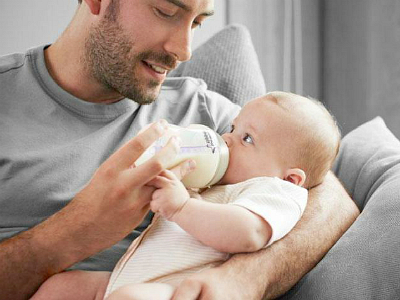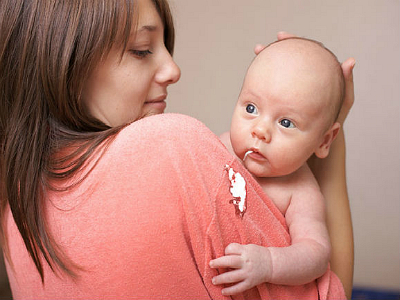1 Key signs in newborns
How to identify colic? Colic is called paroxysmal pain in the abdomen of the child. She appears suddenly. The newborn changes his behavior dramatically. Calm and complacent mood instantly disappears. The baby suddenly wrinkles his face and begins to cry. The baby twitches convulsively with his whole body, arching his back and pressing his knees to his stomach. He pulls his legs and vigorously waving his hands. His body becomes tense, literally squeezed into a lump. Actions of the baby are accompanied by a loud heartbreaking cry. The face of a suffering baby becomes crimson. His strained tummy hardens and acquires a convex shape. The baby can not be reassured.
Do you have gastritis?
GALINA SAVINA: "How easy is it to cure gastritis at home for 1 month. Tested method - write down the recipe. ..!"Read more & gt; & gt;

We recommend to read

Why does hiccups develop in infants
The newborn scares its young and screaming young mother. She tries to rock him, gives him a breast. Usually babies quickly calm down while sucking. But with colic, the infant, as a rule, resolutely rejects the breast. In some cases, he can greedily grab his nipple with his lips and start sucking milk, but after a couple of minutes he resolutely turns away from her. After feeding his cry becomes even stronger. All attempts by the mother to calm the child do not give the desired result.
During the attack, the child periodically releases gases. In an upright position, he exits the air. The newborn can belch several times. During colic, the child becomes very restless and irritable.
Just as suddenly as it starts, so the colic ends. The child abruptly becomes silent and calms down. His skin quickly turns white and acquires a healthy shade. The kid relaxes, becomes sluggish and looks tired. He can almost instantly fall asleep. But a new attack of colic awakens him and makes him scream again.
How to recognize colic in a newborn? Attacks of colic usually occur during meals. The kid suddenly starts to writhe painfully, several times in a row grabs and throws the nipple. A painful spasm can also appear immediately after a meal or between meals.
From intestinal colic, children suffer more often in the evening and at night. Spasms can torment them for several hours in a row.
-
 IMPORTANT TO KNOW! Gastritis? Ulcer? To prevent a stomach ulcer from turning into a cancer, drink a glass. ..Read the article & gt; & gt;
IMPORTANT TO KNOW! Gastritis? Ulcer? To prevent a stomach ulcer from turning into a cancer, drink a glass. ..Read the article & gt; & gt;
Characteristic sign of intestinal colic are changes in stool. It changes the golden color to green, contains undigested pieces of food.
2 Baby reactions
To understand that a child has colic, it is possible by his reaction to heat. If you press the baby's tummy to the mother's body, the colic becomes less painful. The baby will noticeably cheer up and calm down a bit. His cry will not be so intense. He will cry plaintively, trying to sleep. Contact with the mother's skin will have a beneficial effect on him. The knock of her heart will remind him of a pleasant intrauterine period.

The psycho-emotional state of the infant directly affects the strength of the onset of intestinal pain. The warmth and pleasure of contact with the mother can completely eliminate the weak intestinal colic in the newborn or make them quite tolerable.
A similar effect occurs when the baby is placed on the stomach, ironed with a hot iron folded in several layers of diaper. Soft heat, coming from heated tissue, relieves spasms and dulls the pain. The kid calms down and relaxes. He can eat and fall asleep until the nappy gets cold. Changing the cooling diapers on warmed, you can alleviate the condition of the baby for a long time.
-
 Gastroenterologist. IMPORTANT: "I beg you, if you began to worry about abdominal pain, heartburn, nausea, do not in any way do gases. .."Read more & gt; & gt;
Gastroenterologist. IMPORTANT: "I beg you, if you began to worry about abdominal pain, heartburn, nausea, do not in any way do gases. .."Read more & gt; & gt;
There is a direct correlation between the ingestion of air by an infant and the appearance of colic. The child becomes slightly lighter in an upright position. In this position, the gases that cause bloating and painful spasms intensively emerge. The pain subsides after the use of a gas tube for newborns. To release the intestines from the baby's gases spread on the tummy. After the release of air, the baby naturally experiences instant relief.
Often, intestinal cramps disappear immediately after a defecation of a newborn. He calms down and immediately falls asleep, not paying attention to the contaminated diaper.
If you feed a newborn in an upright position, much less air will enter your body. Attacks of pain will become less intense and will occur less often. Reduce the likelihood of spasms can change the infant formula and the exclusion of gas-forming products from the mother's diet.

To determine that a baby has colic, you can by his reaction to bathing. Noticeable relief of the baby's condition occurs immediately after immersing it in warm water. A warm bath relieves painful spasms, the baby becomes a little lighter and calms down for a while. However, after a bath, the attack increases again.
TIP FROM THE MAIN GASTROENTEROLOGIST
Korotov SV: "I can recommend only one remedy for the rapid treatment of Ulcer and Gastritis, which is now recommended by the Ministry of Health. .." Read testimonials & gt; & gt;
3 Dynamics of the severity of
symptoms Colic begin to appear vividly at the age of 3-4 weeks. Some newborn spasms appear around the clock with small interruptions. Strongly expressed intestinal spasms do not allow the newborn to fully eat and sleep. If the attacks of pain torment babies all day, he may not gain weight. However, most children excel in weight, despite regular pain.

As the child grows up, the nature of the bouts of pain changes. They appear less often and last less. The incomplete digestive system of the newborn gradually develops. Food is better digested and digested. The chair acquires a uniform consistency, a characteristic pleasant, slightly sour smell and golden color.
Colic does not appear as dramatically as before. At first the baby becomes restless. He often wakes up, groans, knocks, arches his back and wriggles. Then he begins to cry softly. As the pain intensifies, the intensity of the scream increases. However, heart-rending cries arise less and less often. Only the irritability of the baby and his weak crying can testify to the seizure.
Over time, attacks are so weak that the child only temporarily spoils the mood. He can frown during colic, without interrupting his sleep.

A slight increase in colic may occur after the introduction of a new infant formula or the addition of new products to the mother's diet. Especially those that contain a lot of fiber.
Already in 2-2.5 months after birth, many babies have a noticeable improvement in their well-being. They are mostly in good spirits, they cry less and eat better. In some cases, severe colic affects a child up to 4 months. In male babies, colic can be more pronounced, they appear a little longer than in newborn girls. However, at the 5th month of life, the vast majority of children completely get rid of painful attacks.
4 Alarming signs of
Parents should be alerted if the baby very often and plentifully regurgitates or has a feeling that the baby belches everything that it eats. An alarm sign is a strong regurgitation of a "fountain", reminiscent of vomiting. The reason for urgent medical attention is the blood in the vomit.

A dying condition of a baby is considered a dangerous sign.
After an attack of ordinary colic, he may look sleepy and tired. However, the child is quickly gaining strength and recovering.
If the baby often cries and does not look awake between bouts, it should be shown to the doctor. An alarming sign is a significant shortage of weight, developmental lag, poor sucking of the breast, pale skin.
If the toddler is constantly pushing, he has a strong flatulence and rumbling in his stomach, you need to inform the doctor about it. An alarming symptom is the fetid stool odor, as well as the presence of blood, mucus and purulent masses in it. In this case, you should immediately contact a doctor.
Severe diarrhea or constipation may also be a hazard to the newborn. It is necessary to monitor the child's temperature. A rise in body temperature above 38 ° C is a sign of the disease.
You should consult your doctor if a baby has a rash. If during a fit of pain the baby cries hoarse, he has trouble breathing or he begins to suffocate, urgent medical attention is needed. It is dangerous when there is rapid heart beat or shortness of breath. It should be understood that such symptoms can be a sign of a serious illness.
The reason for the excitement is the lack of positive dynamics in the development of the digestive system of the baby. If after 2-3 months there is no improvement, the colic is excruciated with the same strength and frequency, you should see a doctor for a survey. The cause of colic in 5% of infants may be organic pathologies.
It is necessary to consult a doctor if the pain starts appear more often or appear more strongly. Especially if other suspicious signs of trouble have joined.
The child's health is evidenced by his appetite. In the interval between attacks of intestinal colic, he should eat well. If the baby has lost interest in food, this is a bad sign.
- 1 Key signs in newborns
- 2 Baby reactions
- 3 Dynamics of symptom severity
- 4 Alarming symptoms of
When a tiny newborn crys out hysterically, young parents panic. How to understand that a child has colic, and not a serious illness? Painful sensations in the tummy occur in infants as a result of natural adaptation of the gastrointestinal tract to new environmental conditions. Knowing how to manifest colic, you can distinguish them from signs of developing pathology.


